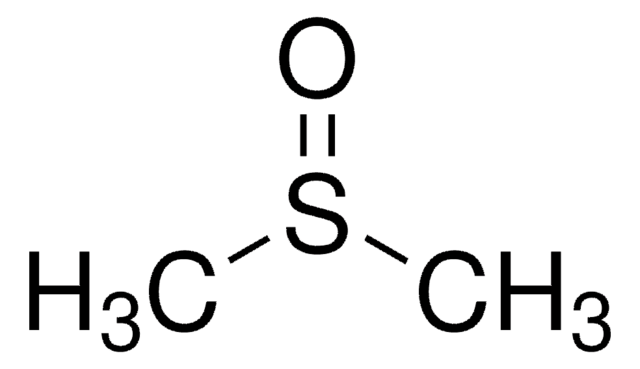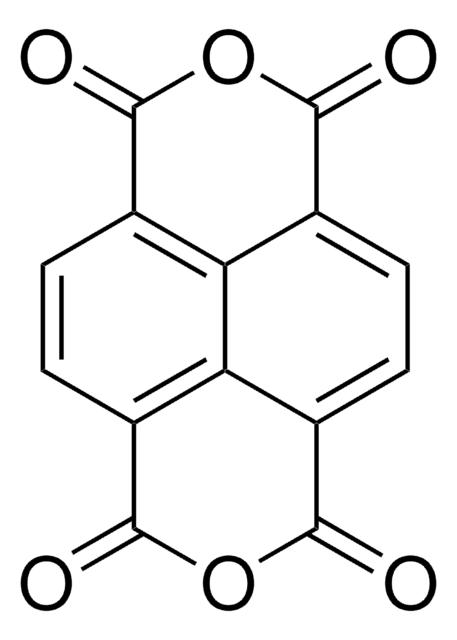932760
3,4,9,10-Perylenetetracarboxylic dianhydride
동의어(들):
PTCDA, Perylenetetracarboxylic acid dianhydride, Perylene-3,4,9,10-tetracarboxylic dianhydride, Pigment Red 224
로그인조직 및 계약 가격 보기
모든 사진(2)
About This Item
실험식(Hill 표기법):
C24H8O6
CAS Number:
Molecular Weight:
392.32
Beilstein:
57831
MDL number:
UNSPSC 코드:
12352103
NACRES:
NA.21
추천 제품
분석
99% (sublimed)
Quality Level
mp
>300 °C
solubility
DMSO: slightly soluble
오비탈 에너지
HOMO 5.85 eV
LUMO 3.9 eV
SMILES string
O1C(=O)c2c3c4c(c5c6c(c4cc2)ccc7c6c(cc5)C(=O)OC7=O)ccc3C1=O
InChI
1S/C24H8O6/c25-21-13-5-1-9-10-2-6-15-20-16(24(28)30-23(15)27)8-4-12(18(10)20)11-3-7-14(22(26)29-21)19(13)17(9)11/h1-8H
InChI key
CLYVDMAATCIVBF-UHFFFAOYSA-N
유사한 제품을 찾으십니까? 방문 제품 비교 안내
애플리케이션
3,4,9,10-Perylenetetracarboxylic dianhydride, also known as Perylenetetracarboxylic acid dianhydride, is a large π-conjugated semiconductor aromatic organic molecule. It is an organic dye molecule and an organic semiconductor. It is used as a precursor to a class of molecules known as Rylene dyes, which are useful as pigments and dyes. It is a dark red solid with low solubility in aromatic solvents.
The compound has attracted much interest as an organic semiconductor. It has potential applications in organic and molecular electronics, and typically used as an archetype molecular compound. PTCDA shares many properties with conventional semiconductors (with their delocalized electronic states), and insulator-like organic molecular crystals (OMCs) (with their large absorption oscillator strengths, excitonic self-trapping, polaron-assisted conduction, etc.). That is due to extremely close π-π stacking, an unusually small intermolecular distance of only 3.21 A. Among its applications, it is important to highlight the latest focus on environment monitoring, self-assembly and photocatalysis.
The compound has attracted much interest as an organic semiconductor. It has potential applications in organic and molecular electronics, and typically used as an archetype molecular compound. PTCDA shares many properties with conventional semiconductors (with their delocalized electronic states), and insulator-like organic molecular crystals (OMCs) (with their large absorption oscillator strengths, excitonic self-trapping, polaron-assisted conduction, etc.). That is due to extremely close π-π stacking, an unusually small intermolecular distance of only 3.21 A. Among its applications, it is important to highlight the latest focus on environment monitoring, self-assembly and photocatalysis.
Storage Class Code
11 - Combustible Solids
WGK
WGK 1
가장 최신 버전 중 하나를 선택하세요:
Kangyi Kong et al.
Chemical communications (Cambridge, England), 55(56), 8090-8093 (2019-06-25)
In this communication, a self-assembled supramolecular system consisting of phosphoric acid substituted perylene diimide (P-PMPDI) has been successfully developed for highly efficient photocatalytic hydrogen evolution. Compared with a carboxylic substituent perylene diimide (P-CMPDI), P-PMPDI showed a superior H2 evolution reaction
Self-assembled perylene diimide based supramolecular heterojunction with Bi2WO6 for efficient visible-light-driven photocatalysis
Zhang, Kai, et al.
Applied Catalysis. B, Environmental, 232, 175-181 (2018)
Wenwu Zhou et al.
The Science of the total environment, 780, 146483-146483 (2021-03-28)
Environment pollution is getting serious and various poisonous contaminants with chemical durability, biotoxicity and bioaccumulation have been widespreadly discovered in municipal wastewaters and surface water. The detection and removal of pollutants show great significance for the protection of human health
Mohammad Rezwan Habib et al.
Nanoscale, 10(34), 16107-16115 (2018-08-17)
We report the photoluminescence (PL) characteristics of a van der Waals (vdW) heterojunction constructed by simply depositing an organic semiconductor of 3,4,9,10-perylene tetracarboxylic dianhydride (PTCDA) onto a two-dimensional MoS2 monolayer. The crystallinity of PTCDA on MoS2 is significantly improved due
Zijian Zhang et al.
Advanced materials (Deerfield Beach, Fla.), 32(32), e1907746-e1907746 (2020-07-01)
A highly crystalline perylene imide polymer (Urea-PDI) photocatalyst is successfully constructed. The Urea-PDI presents a wide spectrum response owing to its large conjugated system. The Urea-PDI performs so far highest oxygen evolution rate (3223.9 µmol g-1 h-1 ) without cocatalysts
자사의 과학자팀은 생명 과학, 재료 과학, 화학 합성, 크로마토그래피, 분석 및 기타 많은 영역을 포함한 모든 과학 분야에 경험이 있습니다..
고객지원팀으로 연락바랍니다.






![9,9-Bis[4-[(4-ethenylphenyl)methoxy]phenyl]-N2,N7-di-1-naphthalenyl-N2,N7-diphenyl-9H-Fluorene-2,7-diamine ≥98% (HPLC)](/deepweb/assets/sigmaaldrich/product/structures/217/694/0386f9cf-a92c-48f3-bde7-f7a23d7cdc3a/640/0386f9cf-a92c-48f3-bde7-f7a23d7cdc3a.png)